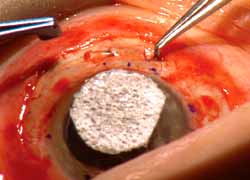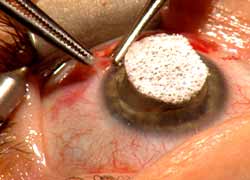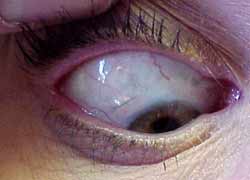Implant for correcting presbyopia enters clinical use in Europe
Precise surgical placement is necessary to achieve the accommodative effect and to maintain implant stability.
|
|
|
|
|
|
| All photos courtesy Howard N. Straub, DO. |
After receiving approval for sale within the European Union earlier this year, the RestorVision Reading Implant has begun use in clinical practice as a treatment option for presbyopia.
Deepak K. Chitkara, FRCOphth, director of the Rosen Eye Clinic in Manchester, England, was the first ophthalmologist in Europe to use the device in practice since its approval. Twelve patients have received the implants and are able to read without additional correction, according to Dr. Chitkara.
Dr. Chitkara, who had experience implanting the devices as part of preclinical testing and evaluation, told Ocular Surgery News that patients generally note an improvement in vision immediately postop, although it can take up to 6 to 8 weeks for vision to stabilize. It also takes up to 2 weeks for patients to completely heal from the surgery.
“As they come off the table, as they sit up, if you hand them a book they will be able to read it,” he said. “What is amazing is that they will start reading with the other eye as well. But it takes about 4 to 6 weeks for the eye to fully settle. Patients are shown reading exercises which are essential in the first few weeks to maintain the reading ability. Reading improves as time goes by over those weeks.”
RestorVision Implant
The RestorVision Reading Implants are designed to correct presbyopia only. The implants are not suited for correcting other refractive errors or distance vision, Dr. Chitkara said.
Best candidates for the implants are patients in the presbyopic age group of 40 to 70 years.
“If you need distance, then you need one of the other procedures to correct for distance, like laser,” he said.
The implants are small PMMA segments approximately one-third to one-half the length of a grain of rice, according to product literature and Mr. Chitkara. Four implants are inserted in scleral tunnels around the globe of one eye only, roughly 3 mm from the limbus and at about half depth within the sclera.
Dr. Chitkara said the implants are supposed to compress the ciliary muscles, allowing them to contract more efficiently. He explained the implants act on the theory that presbyopia is caused by the ciliary muscles becoming more relaxed and lazy with age, which results from expansion of the lens.
“As you get older, there isn’t enough space for the ciliary muscles to act. They become lax and do not work well,” he said. “What this does is put the ciliary muscle in a slightly contracted position from which it can act more efficiently.”
Although the implants are inserted only in one eye, the effect is achieved in both eyes. Dr. Chitkara said this is believed to be the result of what he called a feedback loop to the brain. The implanted eye sends a message to the patient’s brain that the ciliary muscles are contracting. The brain then sends an impulse to the ciliary muscle of the fellow eye, forcing it to work equally hard.
Dr. Chitkara noted the implants may be used in patients who have undergone prior ocular procedures, such as LASIK. However, there are some existing conditions contradicting their use. The implants are not recommended for use in patients with glaucoma, rheumatoid disease or arthritis, or in patients who have uveitis, scleral disorders or scleral thinning disorders, such as scleral malacia.
Patients with sickle cell disease are also excluded because the implants, if placed in the wrong position, can cause compression of blood vessels and subsequent coagulation. This can be dangerous for patients who are already prone to coagulation.
Precise implantation needed
According to Dr. Chitkara, the implantation procedure takes approximately 20 to 30 minutes to complete.
Patients are first administered Valium (diazepam, Roche) as a sedative, followed by topical anesthesia applied to the eye. A fornix-based flap is dissected.
The eye is marked while the patient is in the sitting position, allowing the 6 o’clock and 12 o’clock positions to be easily identified and allowing identification of the recti muscles in the four quadrants of the globe.
Dr. Chitkara said this is important because the implants must be placed in tunnels of precise dimensions. If the tunnel is too large, the implant will wobble and be ineffective. If the tunnel is too small, it will be difficult to place the implant, and it could cause the wound to tear.
Once the sclera is marked, the tunnel is created using a diamond blade specifically designed for the procedure. The implants are delivered between the recti muscles using an inserter. The inserter and knife are sold as a kit for the implant.
After the implants are placed, absorbable sutures are used to close the conjunctiva.
Scleral erosion possible
Small study indicates reading implant |
| The RestorVision Reading Implant may provide long-term correction of presbyopia, according to a prospective, noncomparative case series. The study, initiated in 1999, included 33 eyes of 39 patients and assessed safety and efficacy of the implants. All patients experienced an improvement in bilateral postoperative near vision, while distance vision remained stable. According to the study by Howard N. Straub, DO, developer of the implant, 54% of the participants had been followed for over 2 years and 36% followed for over 3 years. The majority of patients were implanted in only one eye, although six patients received bilateral implants. According to the study, 87% of patients discontinued use of reading glasses, and 93% had decreased their need for near add. Both results were sustained over the course of the study. Additionally, 94% of patients gained 2 or more lines of near with an average of 5.5 lines gained, and 80.6% had an improvement of more than 1.5 D of add. Four patients developed increased IOP of up to 30 mm Hg, which was attributed to steroid use of 1% prednisolone acetate. All IOP increases were controlled using topical medications and returned to normal within a few days. Two patients had two implants externally extrude. |
Source: Data on file with RestorVision |
Uncorrected near vision, distance-corrected near vision and amplitude of accommodation are all measured using standard eye charts under standard lighting conditions. Dr. Chitkara said there is usually a five to six line improvement in near vision, although about 4% of patients still require spectacle correction.
Dr. Chitkara said that in addition to the patients implanted as part of his clinical practice, about 150 patients have been implanted overall to date, with one patient followed for 3.5 years. This patient has maintained his reading ability at the same level it was on postop day 1, he said.
Dr. Chitkara said patients may feel a mild foreign body sensation for up to 2 weeks postop. Mild dry eyes may also develop.
He said one other potential complication is that the implants may erode through the sclera if the sclera is not adequately thick. If this occurs, the implants can be removed.
Dr. Chitkara said this situation did occur in one patient in whom one implant was placed superficially. However, little loss of effect was seen.
In addition to this patient, Dr. Chitkara said two implants were deliberately removed from the eye of one other patient “to see if the patient could manage with just two.”
“We have found you get little loss of effect if one of the implants does erode through the sclera. We had one patient where we had to remove two implants. And just with two implants he was maintaining his reading vision,” he said.
Reversible
Dr. Chitkara said the procedure has some advantages over intraocular or corneal procedures. The implants can easily be removed, making the procedure reversible. Once the implants are removed, patients return to their original state within 6 months, he said.
The implants are also different from excimer laser refractive procedures because they are placed away from the visual axis, and only one eye requires treatment.
For Your Information:
- Deepak K. Chitkara, FRCOphth, is director of the Rosen Eye Clinic. He can be reached at 10 St. John St., Manchester M3 4DY, England; +(44) 161-848-1500; fax: +(44) 161-848-1519; e-mail: DKC@roseneyecentre.co.uk. Dr. Chitkara has no direct financial interest in the products mentioned in this article, nor is he a paid consultant for any companies mentioned.
- RestorVision LTD, makers of the Reading Implant, can be contacted at 1 Mountainview Road, Greenwood Village, CO 80111 U.S.A.; +(1) 303-882-1680; fax: +(1) 303-793-0662; e-mail: info@restorvision.com; Web site: www.readingimplants.com.



